Part 1
Part 2
Part 3
Integrix 2-12×36 FFP scope: Part 1
This report covers:
- Checked the adaptor fit
- Another report!
- Scope dovetails on the ZRS
- No shims
- The test
- Sight in
- Reticle size
- Scope illumination
- H&N Baracuda Green
- JSB Exact RS
- RWS R10 Match Pistol pellets
- Discussion
- RWS Superdome
- JSB Exact Heavy
- H&N Baracuda Magnum with 4.50mm heads
- Summary
Today’s report isn’t just about a single thing. It’s not even about two things, or even three. Today we get a fourfer! Or at least we get the beginning of four different reports. Call it a one-and-one-halfer.
Yesterday I received from Leapers the scope mounts I needed to mount the Integrix 2-12X36 scope to many air rifles. My plan had been to mount it on the Sig ASP20 because it’s one of the few air rifles I have that has a genuine mil-spec Picatinny scope base, and the scope came mounted in a one-piece Picatinny mount.
The compromise air rifle scope bases I have tried that include both 11mm and Picatinny bases don’t usually accept true Picatinny scope rings. The top part of the rifle scope base with the Picatinny cross slots usually isn’t cut deep enough for the wide jaws on the bottom of the rings to clamp to the rifle’s Picatinny dovetail. I have to use the UTG 11mm to Weaver adaptor in the rings and attach the scope to the upper 11mm rail. But the one-piece UTG scope ring set Leapers sent with the Integtrix is a true Picatinny and has additional cross bars that make using those adaptors impossible.
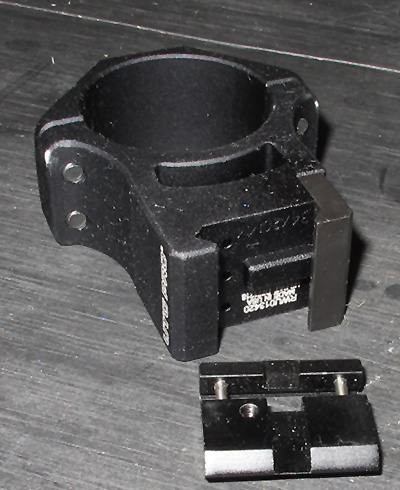
The 34mm P.O.I. high rings have just one cross bar — perfect for the UTG 11mm to Weaver adaptor!
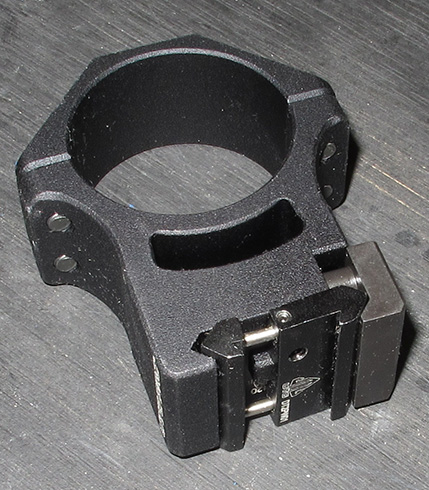
With the adaptor installed the ring is now for 11mm dovetails.
Checked the adaptor fit
I checked to make certain the adaptor will fit the two-piece P.O.I. rings and it does. So why fool around with the ASP20, now that I have what I need to mount the Integrix scope to the Norica ZRS Omnia? Why not go straight there?
Another report!
And, guess what? Because of this decision we get ANOTHER report. Yep, because the ASP20 has worn the Whiskey3 scope since I received the rifle and scope back in 2018. All I did to get ready for the Integrix test was remove the scope by undoing the ring bases that clamp to the rifle. The scope remained in the rings. And I last shot the rifle for accuracy on April 19. So the extra report we get is this — how much does the point of impact change when a scope is removed and then installed on the same rifle with no other changes?
Scope dovetails on the ZRS
The Norica Omnia ZRS has 11mm dovetails. There is no scope stop on the rails, so the scope base has to hold based on the friction it generates. But I don’t think the Omnia needs a scope stop, because when the rifle fires the outer spring tube does not move. The movement that cancels recoil is all done inside the spring tube. So the scope remains still — nothing needs to be stopped.
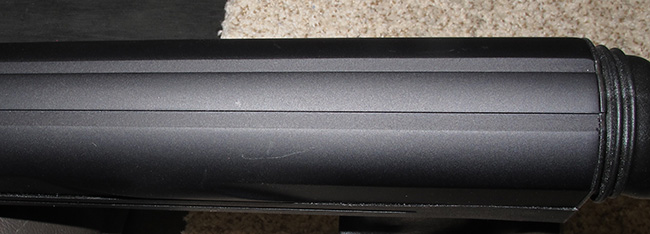
The Norica Omnia ZES has not provision for a scope stop — nor does it need one!
No shims
When I mounted the 2-piece rings on the rifle I did not shim under the rear of the scope. I figured we would find out whether the Omnia droops, or not. And, by the way, when I say that a rifle droops, it doesn’t really droop. The barrel is simply pointed down in relation to the top of the spring tube where the scope rings attach. With all that this Omnia has going on there is more of a reason to droop than most breakbarrels, but I wanted to give it a chance.
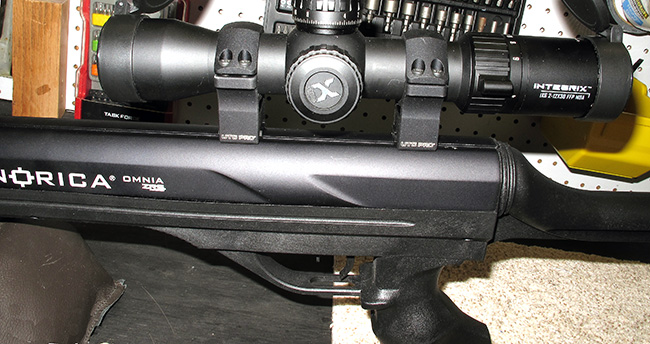
The P.O.I. rings went on the Omnia ZRS in minutes. It’s a pleasure to work with rings that fit!
The test
Today is not a real accuracy test, as you’ll see. I’m getting used to the Integrix scope and also to the Omnia rifle, now that I know where it’s shooting for certain. So I shot 5-shot groups that allowed more pellets to be tested. I shot with the rifle rested directly on the sandbag at 10 meters, because, the way the Omnia works, there is no problem resting it this way. I used all the pellets from the test with open sights in Part 3 except the Crosman Premiers that didn’t do very well. And I added two new pellets. Let’s get started.
Sight in
Sight in consisted of one shot at 12 feet to know that I would be on the paper at 10 meters.Two additional shots were needed at 10 meters to refine the zero. And now I will comment on the Integrix scope adjustment knobs. I WANT ONE! Pull the adjustment knob up to unlock it and then adjust by the audible clicks. You both hear and feel them! Push the knob down and it is locked again. No tools needed!
Reticle size
Because this is a first focal plane scope the size of the reticle changes as the magnification changes. At 2 power the entire reticle looks like a tiny crosshair in the center of the scope. At 12 power the reticle appears full sized. There are thicker lines on both sides and the bottom that point to the reticle when the power is low. It takes some getting used to, but I will run this scope at 12 power all the time, due to the 9-yard parallax setting, so the size isn’t that much of a problem. Also, the illuminated reticle will help.
Scope illumination
To address reader RidgeRunner’s concerns, yes, the Integrix scope has an illuminated reticle. The center crosshair illuminates either green or red in one of 8 levels of brightness. On this scope just push in on the center of the left side adjustment knob that adjusts the parallax range. There is a soft button there and the green or red colors can be selected. The button scrolls through one color and then the other. The level of brightness is selected by holding this button in until the level you want comes up. The brightest level flashes to tell you where you are. You can turn the illumination off with the same button or just leave it on for 12 hours and it turns off automatically.
H&N Baracuda Green
First to be tested were five H&N Baracuda Green domed pellets. The first one hit way to the left of center of the bull, but I just finished the group to see what happened. This one wasn’t pretty. Five Baracuda Greens went into 0.793-inches at 10 meters. In Part 3 this pellet put five into 0.504-inches and I had hoped for better with the scope, but there were no called pulls. This is the way this pellet actually shot.
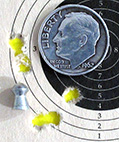
The scoped Omnia put five H&N Baracuda Green pellets into a 0.793-inch group at 10 meters.
Well, that group was a disappointment, to say the least. I adjusted the scope 6 clicks to the right after shooting it and went to the second pellet.
JSB Exact RS
The second pellet was the 7.33-grain JSB Exact RS. Five pellets made a 0.299-inch group at 10 meters. It’s the smallest group in the test.

The 10-meter group of five JSB Exact RS pellets measures 0.299-inches between centers.
RWS R10 Match Pistol pellets
Next up were five RWS R10 Match Pistol pellets. The first two went into the same hole with no growth in size visible. I was so impressed that I went forward and photographed it for you. I thought I might never see that again.
Then I shot the final three pellets. The group did get larger but it’s still not that large. They made a group that measures 0.312-inches between centers. It’s smaller than the group the rifle made in Part 3 with this pellet and open sights, which was 0.334-inches.
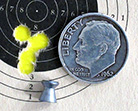
When I shot the last three RWS R10 pellets the group enlarged to 0.312-inches between centers.
Discussion
I’m going to comment here that the Norica Omnia NRS is an accurate air rifle. Yes, it has a world class scope mounted on it, but that doesn’t make it accurate. It just makes it easier for me to be accurate.
The trigger leaves something to be desired. The second stage has a lot of creep and I have to really concentrate to make each shot good.
The Integrix scope is extremely bright and clear. But the small central crosshair, even at 12 power, means I have to use the illumination to see the point of impact. The green color appears brighter to my red-green colorblind eyes.
RWS Superdome
The next pellet I tested was the RWS Superdome. The first three shots went into an open group, then shots 4 and 5 went into the same hole as shot three. I don’t know if this means the Superdomes need to have the bore seasoned, but from the results that’s what it looks like. There are five pellets in 0.493-inches with the last three in 0.108-inches. This is a note to myself to try Superdomes at 25 yards, and to shoot three pellets elsewhere before starting the group.

Five RWS Superdomes made a 0.493-inch group at 10 meters with the last three going into 0.108-inches between centers.
JSB Exact Heavy
I wanted to try a couple heavy pellets so the 10.34-grain JSB Exact Heavy was next. When the first four went into 0.178-inches I was ready to dance in the street, but pellet five opened the group to 0.331-inches. It’s a great group that should have been even greater.

The Omnia really seems to like JSB Exact Heavy pellets. It put five into 0.331-inches at 10 meters with the first four in 0.178-inches.
H&N Baracuda Magnum with 4.50mm heads
The last pellet I tested was the H&N Baracuda Magnum with 4.50mm heads. Five went into 0.557-inches at 10 meters. That’s hardly worth talking about.
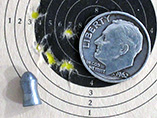
Five H&N Baracuda Magnum pellets went into 0.557-inches at 10 meters.
Summary
What we have in today’s report is:
1. A recoilless breakbarrel spring piston rifle that’s accurate but picky with pellets. It might benefit from seasoning the bore, and that is BB’s note to himself. The barrel does not droop. The trigger has a long creepy second stage.
2. Two-piece UTG 34mm scope rings from Leapers that open up many possibilities for testing the new Integrix scopes that are suited for airguns.
3. A chance to test how much of a POI change removing and remounting a scope makes.
4. A stunningly clear, bright new scope that seems to open a whole new optics future for airgunners.
Remember at the start I said today’s report was a fourfer? That was it.


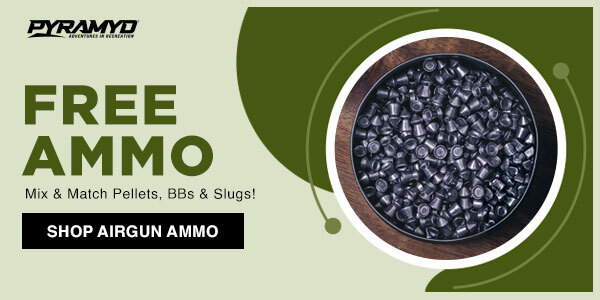
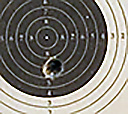
B.B.,
A most interesting report; and I’m not surprised at all by the tiny group you shot with the 7.33-grain JSB Exact RS pellets; I’ve got 3 airguns in which they are extremely accurate. 🙂
Blessings to you,
dave
B.B. those flyers are frustrating…even more so when they come at the end of a group.
Wondering if your rifle has similar issues to reader, 150 Crosman’s. He found a loose screw inside the action.
Now, on to trigger adjustments. Hopefully, you can eliminate some of that creep. And don’t forget to let us know if it is still recoilless if pointed up or down. As I recall the Diana 52 is billed as recoil‐less, but only if shot level.
rg, I also want to see how it will do pointed up and down.
Roamin,
I forgot to do that, didn’t I? Mounting the scope and the shooting took a lot of time and I guess I was focused on that, rather than ancillary things.
BB
Just a friendly reminder, B.B., nothing more. Last night I re-read all the prior posts and comments on this gun, and I though you might find a reminder useful for the next installment. I have to say, this is an interesting gun. I would love to know how it works.
Tom,
This rifle seems to show preference to pellets weighing around 7-9 grains. Any chance of adjusting the creep out of the trigger or is it something that might go away with use?
Siraniko
Siraniko,
I do plan to see what, if anything, can be done to the trigger.
BB
Romell,
Yes, I’m aware of the adjustments. I often withhold what I’m doing or about to do to keep from writing blogs in the comments.
Thank you for taking the time to research this for me.
BB
Dear Tom.
The trigger can be adjusted by two screws as you can see in the instructions supplied by the manufacturer.
BB,
IMMHO, the ZRS is a great idea, executed poorly. It deserves a better stock and a much better trigger. Hopefully you will be able to do something with that trigger. Umarex attempted to deal with the sproinger recoil a while back. It apparently was also executed poorly. I have not heard anything about it since.
As for this scope, if it was not so expensive I might like it also. I do wish they would put that awesome glass etched reticle in a Bug Buster. SFP is fine by me as I rarely change the magnification setting of my scopes. I can probably do without the illumination also. I do not use it on any of my scopes. I do not even have batteries in them.
Once again the seasoning question raises its ugly head. It will be most interesting to see how that goes.
I am also quite curious about the replacing the scope on the ASP20. Can you get it back in the same spot and how much will it be off? In the movies they do it all of the time.
Back to the scope for a moment. Once you have “set” your color preference and brightness on the illumination, does it return to that setting when you turn it off and on?
RR
“I can probably do without the illumination also. I do not use it on any of my scopes. I do not even have batteries in them.”
Me either. Most of my many scopes come with it but it offers no advantage for my eyes when shooting targets. I get it that some hunters in low light may want it and BB sometimes uses it for color blindness. I’m wondering how many scope users actually want this feature. Do readers on this blog use illumination? Could be a cost savings to make it optional or even doing away with it.
Deck
I use it occasionally to help see target bulls, especially in lower light. I prefer to purchase illuminated scopes. All my scopes are.
Mister AP,
Thank you. I was waiting for someone to say that. I have said it many times in my reports. I have never used an illuminated scope for hunting, because when I hunted illuminated scopes didn’t exist. But I use them all the time for seeing into darker targets for exactly the reason you stated.
BB
MisterAP
Thanks for weighing in. Hoping others will chime in.
Deck
FM will chime in with his two cents’ worth-less – in Casa FM, the only illuminated optic is the Red Dot mounted on the .177 Maximus which works fine for target shooting/plinking. Have occasionally used it for iguana hunting/pesting and works well enough for that purpose but usually leave that to the fixed-sight or Whiskey3-equipped .22 “artillery.”
I now have one scope with an illuminated cross hair, a discontinued Hawke. The entire crosshair gets a red or green halo of sorts. I find it distracting. I think I would prefer Tom’s Meopta with a very tiny dot at the center.
Decksniper-
I have several scopes with illumination. If I was just punching paper I don’t think there would be a discernible difference. Alas, my world isn’t black and white. Most targets (non paper) are a range of colors with a range of lighting conditions. A lighted center dot or crosshair is better, and quicker, when trying to pick out the groundhog’s head in the dappled shade at the edge of the field.
As is pointed out by others, some use it and some don’t. It would be nice to have the option. There are scopes out there that do not have illumination. I just received a brand spanking new Hawke 3-12X44 side focus that does not have illumination.
Like BB says, when I was hunting, you did not have illumination, so I am used to not having it. I normally do not shoot into dark targets, so it does not help me.
Almost all scopes have it these days because marketeers have convinced them everyone wants it. Also it is easier to make them all the same than some with and some without.
To each his own, I guess.
Ridge,
I do see now it is available with a wood stock. At least thats going for it.
Doc
Doc,
The stock wood looks nice in the picture.
FYI:
https://www.pyramydair.com/product/norica-omnia-zrs-air-rifle-wood-stock?m=5937
Tom Gaylord: “When the first four went into 0.178-inches I was ready to dance in the street, but pellet five opened the group to 0.331-inches.”
Roamin’ Greco: “Those flyers are frustrating…even more so when they come at the end of a group.”
I was thinking the same as Roamin’. I’ve often had pretty tight groups right up until the last shot, which then opened things up. But then a second thing popped into my head. Might the 5th shot have opened things up because of the exhilaration, the desire to “dance in the street”? If one takes a few more seconds to collect himself, might that 5th shot be more cooperative?
Michael
Michael,
Believe me, I thought about that. That group of four was so promising! I did concentrate on that shot, but was I distracted by my angst? It’s very possible.
This is one of the reasons why I like 10-shot groups over five.
BB
B.B.
10 shot groups in order to compensate (?) with the psychological factor, among others of course.
I can smell a blog topic but who am I to tell?
Bill
The military test helps diminish the effect of fliers. But it requires 25 shots (5 shots at each of 5 targets). Determine the average group size and also the single best 5 shot group. I used it for awhile but still prefer shooting 10 shot groups. So does BB I think but 5 shot groups often makes sense for keeping the length of test sessions to a reasonable time.
Deck
That’s tough when trying to test a lot of pellets. But probably good when you have it narrowed down.
Ah, but you still have the issue of the last shot being the flyer. When measuring for accuracy of the rifle only, I am now leaning toward 10 shot groups but ignoring the first few erratic pellets at the beginning of the string, especially if I am switching between pellets (call it seasoning the bore if you like) or making some other adjustment to the gun, and ignoring any final errant shots. So I may have a group of 13 shots where I ignore the first couple if they are way outside of the rest of the group and the last shot, and measure the 10 shots in between. But if they all group together in a way that makes sense, I count them all. The other way is to buy software that “watches” each shot and measures the distance to a calculated center of the group and gives you statistics about your accuracy and precision. One reader has such a system and sometimes posts screenshots of his sessions.
Roamin
“Ah, but you still have the issue of the last shot being the flyer.”
Yes, if you are referring to 10 shot vs 5 shot groups. The military test discounts the flier quite a lot because of averaging 5 different groups.
Deck
Without getting too metaphysical, how would you really know? Heck it’s fun to ponder, but at the end if the day, you have to shoot many groups to see if things are repeatable. B.B.’s tests can only give us a snapshot, a glimpse of what the performance might be, and then only for that particular gun he is shooting. Your mileage may vary, as they say.
Now that reminds me to wrap up my shooting matrix regarding pellets vs. # of pumps on the 362 and finding the golden pellet and power adjustment on some Crosman Mark I and IIs. I have a birthday present to give soon.
Roamin’
If it’s fun to ponder, ponder I surely will. ;^)
Michael
B.B.,
Looks like a great scope mounted on a 3+ MOA air rifle. I’m much more interested in your scope discussion.
Does the POI shift when lights out, does POI shift with RED, or with Green illumination?
On remounting the ASP WHISKEY3 scope on the ASP20 will you torque it or just finger/wrench tighten it to the 1913 PICATINNY rail?
Pretty Please!
shootski
shootski,
I’ll test the POI shift next time. Since I’ll be shooting at 25 yards if there is a shift we should be able to see it.
I will tighten the Whiskey3 as tight as it was before, which was tight.
BB
I’ve had an instance of a scope (Bestsight 6-24×50 AO) moved from one rifle (SAM) to another (Avenger bullpup), rings and all, and it was still zeroed in left to right! Probably would have been a good time to play the lottery!
BB-
Might I suggest that a ‘fivefer’ showed up in today’s blog. How about clearing up the accuracy versus precision semantics. You had several groups that were precise- ie, small dimensional spreads. None were accurate- ie, not centered on the black bullseye.
Put another way- when your mortar crew dropped one in the tank’s hatch, that’s accuracy. Dropping four more in the hatch is precision.
hope to see a report on the .22 norica dream hunter
This talk about how to make “flyers” disappear in the calculations seems somewhat comical to me. 🙂
Regardless of names allocated, I think that all impacts that occurred should be counted – equally, remembering that, typically, the group would have been even larger, had more shots been taken! 🙂
Of course, there are all sorts of reasons for how many shots to take.
For example, I imagine that in hunting, the theoretical ideal is, one shot! How about that for avoiding ‘flyers’, eh. 🙂
Finally, who’s to say whether the real flyers were the ones in the minority? 🙂
I appreciate your point of view.
It boils down to statistics and expectations. I try to figure out, as best as I can, the potential of the airgun for repeatable precision, then accuracy, so I have a standard by which to judge my own shooting skill with that weapon. Which I know needs work.
Let me give you an extreme example for argument’s sake. Let’s say you locked a gun in a vise and shot 100 shots and made a 3 cm hole at 30 meters. You would expect with a fair degree of certainty that any shot that follows will fall somewhere within that hole. You would not expect the circle to keep growing forever. The game is to try to predict the performance of the gun with only 5, 10, 20, you decide the number of shots, so you have a reasonable certainty where the gun will hit on the next shot. Most of the time we get there with out thinking about statistics, but its still there. So by throwing out certain shots that may be suspect because you just changed pellets or adjusted a trigger or hammer spring, or because your heart was racing at 4 shots that just went into one hole, we are trying to get to the performance of the airgun itself. Because we know, once the gun is out of the vice, all sorts of other things affect precision.
Roamin Greco, I understand your reasoning and yet I have different thoughts. 🙂
For example, I wonder whether any airgun itself will shoot the same, regardless of the way it is supported, including that vice?
For example, in the case of that vice, I would expect results to vary, according to which part of the airgun gets clamped, how large the clamp is, how many clamps are used and what material the clamp is made of and, of course, how tightly the airgun is clamped. 🙂
Even if it were genuinely possible to completely eliminate the human influence from each shot, then, by that very definition, the results cannot possibly indicate how a human would score with that same airgun. 🙁
However , I can imagine how excited a robot might get… ! 🙂
I don’t put airguns in a vise, but I was just trying to convey the concept of why one might ignore certain shots in a group. I do shoot them from the bench-rest and try to find the hold that seems to give the best groups and then go from there. Once I changed pellets in an air rifle I was testing and literally watched as each shot “walked” down a diagonal line for about an inch. Then all subsequent shots with that pellet stayed in the same 0.5 inch hole. In such a case, should I count the first few shots as representative of that gun-pellet combination’s performance?
Roamin
No, as you succinctly pointed out above, statistical analysis is a useful tool for just about everything, science and manufacturing are examples.
Deck
Sorry Roamin Greco, I think I may have misunderstood.
Of course, only count the shots that suit your investigation and dismiss those that can be explained away. But, I think, most important is whatever makes you feel good in this fun hobby! 🙂
I also apologise for repeatedly using the word “vice” – oops – when, as you correctly wrote, I actually meant a ‘vise’. What a difference an ‘s’ makes, eh? 🙁
Hihihi, I thoroughly enjoy your contribution to our little community. The paramount concern, of course is FUN!
hihihi,
Once again you get to the nut of the issue.
Are there such things as UNCALLED Flyers once we get past a certain amount of training or experience.
In the accuracy/precision testing that Tom does we are being given a look at the approximate potential of an airgun, scope, sight system, projectile. It really only comes together when we shoot our airgun, our projectile of choice, with our sight system, our degree of skill, and for our purposes.
Just the other day i had a .22 caliber airgun Off Hand and was checking sight in at 50 yards (45.7 meters) and although i was satisfied that the Sight In was complete i kept firing at the Sighter Bull for at least thirty more shots. I had no uncalled flyers (no Flyers at all) and the very round group was approximately two MOA. So if i was hunting in very similar conditions i could be almost 100% certain of hitting a 2″ vitals zone IF i know my preys anatomy from all effective angles and the range is similar or closer.
That is why i enjoy BIATHLON because you shoot at five falling targets, prone or standing, having just skied some number of kilometers, much more realistic than Field Target (in my opinion) and loads better for you too!
shootski
shootski, thanks for your repeated flattery but please, no more (Bitte, das bedeutet, Mehr.). 🙂
What a great idea, to shoot many, many pellets at the same target, by which to better see the true impact-group diameter.
I must remember to continue past my usual five or ten, next time… 🙂
As you pointed out, understanding that particular shooter-airgun-situation can really have practical benefits. 🙂
Field Target seems to be ideal for anoraks to yoga, while shooting unicycle guns. Disclaimer: I admit to neither having participated in, nor even witnessed this challenging discipline.
Biathlon is another alien-to-me activity, apparently reserved for those with a penchant for wearing multicoloured tights and swimming caps while meandering about on stretched skates. It looks exhausting and exhilarating at the same time!
For me, the challenge is, to ski without transitioning to prone… 🙂
Hi BB,
Have you written a segment before about trigger tuning? Seem to recall something before with changing the Gamo triggers entirely… but I don’t recall anything about custom tuning. And I’m aware it’s still in practice, though I’ve never had one done. A friend has, with some spectacular results. But when I read these articles on new air guns (Norica Omnia comes to mind) there is a common pattern of lack of trigger refinement and adjustability. I realize very few manufacturers are directing their focus to anything other than PCP’s of late, so getting decent triggers seems out of the question. I’m still a dyed-in-the-wool springer fan, and understand if you want that comprehensive quality – you have to pay for it (TX, almost any HW, Diana T-06). But I love being surprised by underdog rifles with surprising performance. Purchased a Hatsan 95 springer in .25 that performs on par with classic Diana’s. Excellent smooth firing gun with a light, smooth, consistent trigger and phenomenal accuracy. I think I was lucky as a few friends who later purchased 95’s after shooting mine had less than satisfying results. Poor triggers (the Quattro trigger getting some flack)in most cases ruined the experience. My 95 hasn’t been touched or adjusted out of the box. My friend had his 95 tuned and included trigger work – it now shoots as nice as mine but with adjustability as well. Quality control and that design flaw make it tougher to recommend. Just wondering what your thoughts were on the matter.
WesternPA,
I don’t think I’ve written any articles on trigger adjustments in general but I have written plenty of reports on adjusting specific triggers like the Rekord, the Crosman crossbow trigger , the Diana ball bearing trigger etc.
BB
I’m looking at all the groups so far. Even at 10 Meters. I don’t want to be harsh, I’m not too impressed. Maybe adjusting the trigger will help (maybe not).
One item no one has touched on… can the shell of the Omnia be modified to fit other more accurate air rifles with better triggers? (RWS 34, R9, HW 50?)
Looking at other forums, that was another option the original inventor envisioned…wondered if this version left enough room to fulfill that vision.
Tom, I hope you at least explore that option. would be nice to see if any of the mounting holes lined up or at least are semi-close.
JP806,
Nope.
BB